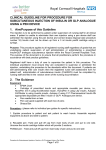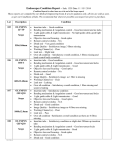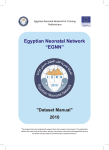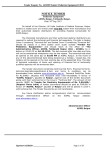Download Transport Incubator and Ventilator
Transcript
TRANSPORT INCUBATOR AND VENTILATOR NEONATAL CLINICAL GUIDELINE.
1. Aim/Purpose of this Guideline
1.1. This guideline identifies the key equipment and testing requirements needed to
ensure that the Neonatal Transport Incubator is safe and fit for use before and after
any transfers take place.
1.2 The purpose of this document is to outline how to use the transport incubator,
the importance of a regular systematic checking procedure and a working knowledge
of the equipment to ensure safe and effective transfers.
1.3 This guideline will need to be acknowledged and followed by all staff that
have any dealings with the transport incubator. This will include anyone who
may be involved with moving the equipment around the hospital and outside of
the hospital grounds.
2. The Guidance
2.1 Handling and using the incubator platform
The incubator platform is made of steel and therefore very heavy when fully loaded,
Therefore, it should always be manoeuvred with at least two members of staff.
There are handles at each end of the stretcher for when it is moved. Please ensure
the brakes are off before attempting to move the incubator.
The platform is equipped to provide intensive care for newborn infants and is
configured to run with internal battery and bottled gas, or external power and
external air and oxygen. The platform holds 4 size ‘E’ gas cylinders, 2 for Medical air
and 2 for Oxygen.
There are a number of plug sockets (10 in total at either end of the incubator) which
can be used when on mains or ambulance power supplies, however please ensure
that the plug extension switches are on and a red light is on the switch. The energy
converter has 2 leads, a red and black lead which needs to be hooked up to the
ambulance in order to run off of the ambulances power supply (please see the
transfer policy for more information on this).
2.2 Daily Checks
The transport incubator and all related equipment should be checked on a daily
basis and before each use. The general hygiene of the incubator should be
Transport Incubator and ventilator. Neonatal Clinical Guideline
Page 1 of 10
maintained ensuring that it is clean and dust free. A separate checklist should be
kept with the incubator which can be signed daily once checks are completed.
The following should be checked daily;
The incubator temperature is pre-set to 36°C and will heat to this temperature when
on unless otherwise changed, please ensure this is correct in mains and battery
mode and ensure the appropriate light is displayed on the front panel.
Check the power failure alarm – disconnect incubator from mains power and slide
out battery tray, the power failure alarm should sound and controller light display.
The doors and portholes open and are not damaged in any way. The Iris port on the
left end of the incubator is closed properly to avoid air leaks.
A humidity sponge is available for use
Check observation light is functional.
Ensure that there are a set of restraining straps, clean sheet is in place and
appropriate bedding available.
The air filter should be changed every 3 months but should also be regularly
checked for dirt build up and changed early if necessary. The date of last change
should be documented on the filter.
Please refer to user manual for further information/troubleshooting. The Incubator
should have a thorough clean with hot soapy water every month and after a transfer
has taken place.
Any problems/damage/faults should be reported and the Nurse in Charge
informed.
2.3 Fabian Ventilator
Fabian neonatal ventilator is an intensive care ventilator for premature babies and
neonates. The ventilator can provide the following ventilation modes; IPPV, SIMV,
SIPPV, PSV and CPAP.
It has an internal rechargeable battery which provides up to 2 hrs operation when no
external electricity supply is available, therefore it must be plugged in at all times
when external electricity is available in order to keep the battery fully charged.
A new complete disposable ventilator circuit should be connected at all times and
the ventilators Exhalation block and Diaphragm (letters TOP facing outwards) in
place, to ensure checks can then be carried out appropriately. A separate CPAP
circuit should also be available for use.
Transport Incubator and ventilator. Neonatal Clinical Guideline
Page 2 of 10
The ventilator needs to have a basic check performed on a daily basis and before a
transfer (please refer to the ventilator checklist), this includes calibrating the oxygen
and flow sensors.
Cleaning- The whole ventilator should be cleaned with detergent wipes between
uses, the ventilator tubing and flow sensor disposed. The exhalation block and
membrane should be sent to CSSD and can be done so 25 times or until it is no
longer intact.
2.4 Fisher Paykel Humidification Unit
The humidifier is used to warm and humidify gases delivered to patients requiring
mechanical ventilation, positive pressure or breathing assistance.
The unit should be kept clean and dust free and be clamped onto the pole near to
the ventilator at all times to ensure that a complete ventilator circuit can be
maintained. Only bags of sterile water should be used with the humidification circuit.
The unit should have a new disposable set between every patient, the temperature
probes and unit itself should be cleaned with warm soapy water between each use
and on a regular basis. Whilst doing this the probes should also be checked for any
damage and replaced if necessary to avoid injury or malfunction.
2.5 Laerdal Suction Unit (LSU)
The LSU is portable, electrically powered, medical suction equipment intended for
field and transport use. It is intended for intermittent operation to remove secretions,
blood or vomit from a patient’s airway to allow ventilation. The machine should be
kept on charge to allow optimum battery time when in use, the 4 battery lights will
be lit when fully charged.
The machine has a disposable inner liner and tubing which should be new and in
place for every patient or replaced when the canister is ¾ full. The canister and
machine itself can be washed with warm soapy water between uses.
The machine integral test function should be performed on a daily basis. To do this
the machine must be set to 500+ mmHG whilst holding the ‘TEST’ button, once the
2nd light on the battery bar has lit up, the suction catheter should be occluded until
all 4 battery lights are alight and it returns to 1 light again, the machine should then
be set back to 0 mmHg. If this all occurs the test is complete and the machine safe
to use. Please refer to user manual for trouble shooting advice.
Transport Incubator and ventilator. Neonatal Clinical Guideline
Page 3 of 10
2.6 Propaq Encore Monitor
The monitor provides ECG, BP and saturation monitoring for the transport of any
infant requiring observation. The monitor needs to be wiped clean with warm soapy
water between uses and on a regular basis and all wires check for damage.
The monitor must be checked on a daily basis and ensured that it is on charge (a
green light will be illuminated on the right hand side) and that all leads are present,
clean and that a saturation wrap is present. The monitor should also be turned on to
check functionality.
2.7 Tom Thumb Infant Resuscitator
The Tom Thumb resuscitator can deliver up to 15 litres per minute and has a dual
flow meter so that infants can be resuscitated in air or variable amounts of oxygen.
A pressure dial can be altered to provide a variable amount of PEEP as necessary
and the visual pressure gauge displays this.
The resuscitator is compatible with single use ‘T piece’ circuits and the unit should
be cleaned as per hospital policy using detergent wipes.
The resuscitator should be serviced every 12 months or if the gauge fails to read
zero when not in use.
2.8 Alaris Intravenous Syringe Drivers
The transport unit is able to accommodate 2 Alaris syringe drivers clamped onto an
adapted metal pole; these can then be plugged into the main bank of plugs. They
must remain plugged in and on charge when not in use.
The pump can be used to deliver fluids and drugs via syringes above 5ml, using the
relevant extension sets. Please ensure specific training has been received on
general functions and alarms before using the driver in this setting.
2.9 Red and Yellow Transport bags
These bags should receive a full check for stock and expiry dates once a month
and after they have been used. Once a check has been performed, a plastic cable
tie with tag must be secured around the zip and dated and the relevant paperwork
signed.
Please follow the appropriate checklist for equipment required within the bags.
Transport Incubator and ventilator. Neonatal Clinical Guideline
Page 4 of 10
3. Monitoring compliance and effectiveness
Element to be
monitored
Lead
Key changes in practice
Tool
Audit.
To be included in the Neonatal Audit and Clinical audit Programme.
Findings reported to the Child Health Directorate Audit and
Neonatal Clinical Guidelines, Meetings
Frequency
As dictated by audit findings
Reporting
arrangements
Acting on
recommendations
and Lead(s)
Change in
practice and
lessons to be
shared
Child Health Directorate Audit and Neonatal Clinical Guidelines
meetings
Paul Munyard. Consultant Paediatrician and Neonatologist.
Paul Munyard. Consultant Paediatrician and Neonatologist.
Required changes to practice will be identified and actioned within
3 months.
A lead member of the team will be identified to take each change
forward where appropriate.
Lessons will be shared with all the relevant stakeholders
4. Equality and Diversity
4.1 This document complies with the Royal Cornwall Hospitals NHS Trust
service Equality and Diversity statement.
4.2 Equality Impact Assessment
The initial Equality impact assessment screening form is at Appendix 2.
Use of the neonatal Transport Incubator and ventilator. Clinical Guideline
Page 5 of 10
Appendix 1. Governance Information
Document Title
Use of the neonatal transport incubator and
ventilator. Clinical guideline
Date Issued/Approved:
12 May 2015
Date Valid From:
07 July 2015
Date Valid To:
07 July 2018
Directorate / Department
responsible (author/owner):
Jenna Julien. Staff nurse
Contact details:
01872 252667
Brief summary of contents
Document providing guidance on the use of the
neonatal transport incubator and ventilator for
internal or external patient transfers
Suggested Keywords:
Neonatal. Transport incubator. Transfer.
Target Audience
RCHT
PCH
Executive Director responsible
for Policy:
Medical Director
Date revised:
January 2015
This document replaces (exact
title of previous version):
New Document
Approval route (names of
committees)/consultation:
Neonatal Clinical Guidelines Group.
Child Health Directorate Audit
Consultant approval
Divisional Manager confirming
approval processes
Sheena Wallace
Name and Post Title of additional
signatories
Not Required
Signature of Executive Director
giving approval
Publication Location (refer to
Policy on Policies – Approvals
and Ratification):
Document Library Folder/Sub
Folder
CFT
{Original Copy Signed}
Internet &
Intranet
Intranet
Only
Child Health. Neonatal. Clinical
Transport Incubator and ventilator. Neonatal Clinical Guideline
Page 8 of 8
KCCG
Links to key external standards
None
Related Documents:
Individual Instruction manuals
Training Need Identified?
In house training on incubator use.
Version Control Table
Date
Versio
n No
10 Jun 10 V1.0
May 2015 V2.0
Summary of Changes
Changes Made by
(Name and Job Title)
Initial Issue
Document reviewed by author and approved
by Neonatal Guidelines Group. Formatted
Author: Jenna Julien.
Staff Nurse
Formatter: Kim Smith.
Staff Nurse
[Please complete all boxes and delete help notes in blue italics including this note]
All or part of this document can be released under the Freedom of Information
Act 2000
This document is to be retained for 10 years from the date of expiry.
This document is only valid on the day of printing
Controlled Document
This document has been created following the Royal Cornwall Hospitals NHS Trust
Policy on Document Production. It should not be altered in any way without the
express permission of the author or their Line Manager.
Transport Incubator and ventilator. Neonatal Clinical Guideline
Page 8 of 8
Appendix 2. Initial Equality Impact Assessment Form
Name of the strategy / policy /proposal / service function to be assessed (hereafter referred to
as policy) (Provide brief description):
Transport Incubator and Ventilator. Neonatal Clinical Guideline
Directorate and service area:
Is this a new or existing Policy?
Child Health Directorate. Neonatal
Existing
Name of individual completing
Telephone:
assessment:
01872 252667
Paul Munyard
1. Policy Aim*
This guideline is aimed at all staff responsible for using the neonatal
Who is the strategy /
transport incubator and ventilator.
policy / proposal /
service function
aimed at?
2. Policy Objectives*
As above
3. Policy – intended
Outcomes*
Audit
4. *How will you
measure the
outcome?
5. Who is intended to
benefit from the
policy?
6a) Is consultation
required with the
workforce, equality
groups, local interest
groups etc. around
this policy?
Audit
All staff involved in the transfer of infants either internally or externally.
Neonatal patients
No. Neonatal guideline group consultant approved guideline
b) If yes, have these
*groups been
consulted?
C). Please list any
groups who have
been consulted about
this procedure.
7. The Impact
Please complete the following table.
Are there concerns that the policy could have differential impact on:
Equality Strands:
Age
Yes
No
x
Rationale for Assessment / Existing Evidence
Transport Incubator and ventilator. Neonatal Clinical Guideline
Page 8 of 8
Sex (male, female, trans-
x
gender / gender
reassignment)
Race / Ethnic
communities /groups
x
Disability –
x
learning
disability, physical
disability, sensory
impairment and
mental health
problems
Religion /
other beliefs
x
Marriage and civil
partnership
x
Pregnancy and maternity
x
Sexual Orientation,
x
Bisexual, Gay, heterosexual,
Lesbian
You will need to continue to a full Equality Impact Assessment if the following have been
highlighted:
You have ticked “Yes” in any column above and
No consultation or evidence of there being consultation- this excludes any policies
which have been identified as not requiring consultation. Or
Major service redesign or development
No
8. Please indicate if a full equality analysis is recommended.
9. If you are not recommending a Full Impact assessment please explain why.
No area indicated
Signature of policy developer / lead manager / director
Paul Munyard
Names and signatures of
members carrying out the
Screening Assessment
Date of completion and submission
07:07:2015
1.
2.
Keep one copy and send a copy to the Human Rights, Equality and Inclusion Lead,
c/o Royal Cornwall Hospitals NHS Trust, Human Resources Department, Knowledge Spa,
Truro, Cornwall, TR1 3HD
A summary of the results will be published on the Trust’s web site.
Signed ______Kim smith________
Date __________07:07:2015______
Transport Incubator and ventilator. Neonatal Clinical Guideline
Page 8 of 8
Transport Incubator and ventilator. Neonatal Clinical Guideline
Page 8 of 8



















